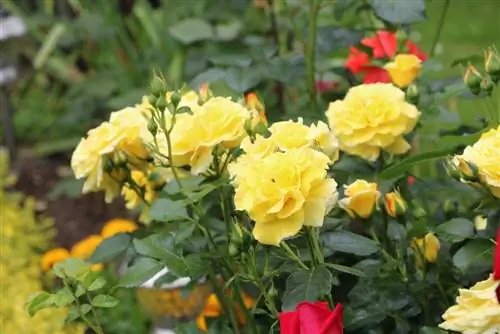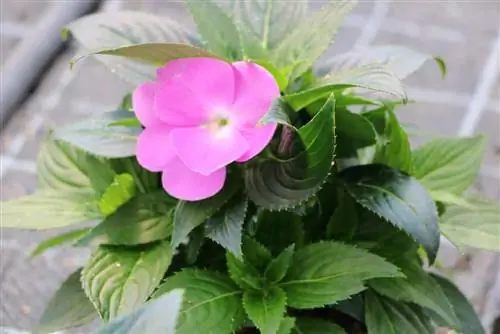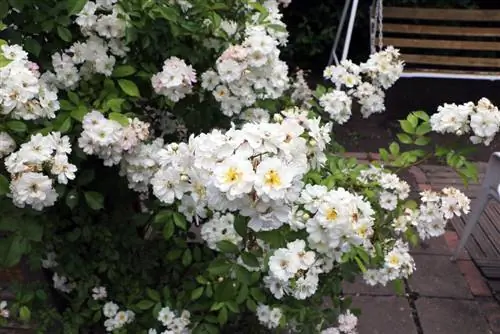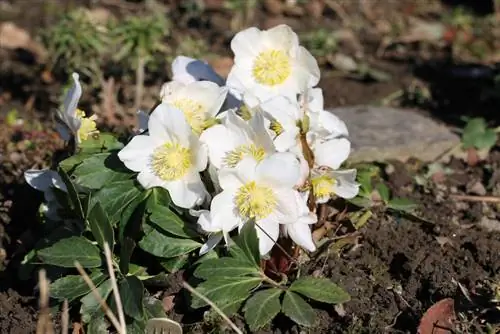- Author admin [email protected].
- Public 2023-12-17 03:39.
- Last modified 2025-01-24 12:45.
Rose lovers should pay attention to the beginning of forsythia flowering in spring. This time marks the beginning of spring, one of the ten seasons of the phenological calendar. Then you can take the first steps to care for your roses. If you follow our tips, nothing will stand in the way of a rich floral display!
Roses
Roses are popular. They give the garden a touch of romance and are a great eye-catcher. They have long been considered delicate and particularly susceptible to diseases and pests. In recent years, rose breeders have released new, more robust varieties in a wide range of colors, shapes and sizes. More and more hobby gardeners are now daring to approach the queen of flowers. Everyone will find their favorite among the beautiful bed, noble, hedge, shrub or climbing roses. Good care at the beginning of the year is rewarded with an abundance of flowers.
Site conditions
Consider the requirements of the rose when choosing the location:
- loose soil
- When planting new plants, choose a location where there were no roses before
- Avoid drought
- water regularly with rainwater, prevent waterlogging
- Heck the bed regularly and remove weeds
Tip:
Garden roses should always be watered directly at the root base when it is dry. Be careful not to allow moisture to collect on the leaves. Wet leaves are entry points for diseases and pests.
Caring for roses in spring
After the end of winter, the foundation is laid for he althy bed, shrub, climbing and noble roses. Spring care for roses includes
- Hilling
- Plants
- Cutting
- Fertilize
- Prevent pest infestation
1. Digging up
In autumn you piled up your garden roses with soil, leaves and brushwood to protect them from frost. Roses newly planted in autumn in particular need this protection. Under no circumstances should it be removed too early. The end of March, when the nights remain frost-free, is the right time. The plants should have sprouted about 15 centimeters before you can remove the winter protection. Choose an overcast day for heeding to allow a smooth transition out of winter dormancy. Strong sunlight after removing winter protection can damage plants.
Tip:
Immediately after digging, loosen the soil at the location.
2. Plants
Container roses can be planted all year round. Bare-rooted plants, on the other hand, are used in autumn from October to November or in spring from March to April.
Instructions:
- Put bare root plants in water for 2 hours
- Short the roots to about 25 centimeters
- cut back above-ground shoots to 15 centimeters
- Loose the soil
- Dig out a 30 x 30 centimeter planting hole and water it
- Insert plant
- Fill up the soil and tamp it down
- pile lightly
Attention:
Do not add fertilizer to the planting hole when replanting!
3. Cutting
Once-flowering garden roses are only cut in autumn. Pruning in spring would reduce flower production. Multi-flowering bed, shrub and climbing roses receive a care cut in spring. The forsythia flower heralds the right time. While forsythia blooms in March in the temperate Central European climate, in higher regions the start of flowering can be delayed until April or May. If you look for the yellow flowers of forsythia in your area, you will find the perfect date.

The aim of the rose cut is to create a beautiful, airy shape. This helps ensure that moisture can dry out quickly and that pests and fungal diseases cannot find any targets. Always use a sharp, clean knife when cutting.
Remove dead shoots
Remove any dead, frozen or diseased shoots.
Cut off weak shoots
Remove weak rose shoots with an oblique cut about 5 millimeters above an outward-facing eye.
Remove wild shoots
Cut the wild shoots too, as these rob the rose of a lot of its strength. Wild shoots can be recognized by their lighter green color. They have more thorns and grow out of the wood below the grafting point. Wild shoots should be cut off as close as possible to the point of attachment.
Tip:
Check the rose bed again and again for wild runners. They grow around the rose and should be carefully dug up with a spade. Simply cutting it off is not enough. It always leads to new shoots.
Short older shoots
The previous year's shoots are shortened by a third for shrub roses. The older, he althy shoots are shortened by three to four eyes.
Bedding roses are shortened to around 20 centimeters above the ground to stimulate growth and flowering. In order to stimulate the formation of additional flower shoots, a perennial shoot in older specimens is cut back to just above the ground.
Climbing roses are only cut from the third year onwards. They then reached a height of two meters. The aim of pruning climbing roses is to promote branching and shape. Old, stunted rose shoots are removed. Long, unbranched shoots are also eliminated.
- Tying climbing rose shoots horizontally prevents the formation of long, thin shoots and promotes branching.
- For low ground cover roses, it is sufficient to cut out the dead and weak shoots in spring.
- Regularly removing spent rose petals stimulates the formation of new flowers.
4. Fertilize
After cutting in spring, the rose needs an additional supply of nutrients. Use a commercial rose fertilizer or work compost into the soil. We recommend using a nitrogen fertilizer in May to stimulate flowering. However, if you added compost in March, you should only use a small amount of nitrogen fertilizer. Over-fertilization can damage the plant and increase susceptibility to diseases such as powdery mildew.
5. Fight pests
The beginning of the gardening season is the right time to look out for pests. When digging, look out for mice that have made themselves comfortable under the warm leaves and like to eat fresh rose shoots. Set up traps if necessary. By the way, you can take a few rose branches from the garden with you for the vase every now and then in the summer with a clear conscience. The cut stimulates the formation of new flowers and you can also enjoy the beautiful flowers in your home.






